French Driver S License In Uk

Use this tool to see if you can drive in Great Britain with your non-GB driving licence. Prospector Plus Program on this page.
Disk on the shop of driving school for learner's driving In France, exists a for people between the age of 15 and 17 and half, for B Driving licence. Some restriction exist; one of the main condition is that a fully agreed licensed must accompany the learner. This Graduated driver licensing is valid only within France, so it's not possible to cross their border with the Graduated driver licensing. Kontakt Vst Rapidshare. With 18, the learner's permit can apply to a normal driving license, that it can pass more easily due to its previous experience; additionally, its probation license is reduced from three to two years. For people over 18, a system similar to the exists, but rules are slightly different, for instance it does not provide the reduction from three to two years for the probation licence.
Driving licences within the are subdivided into different categories (Note: Above graphic may be outdated since 19 January 2013) The European driving licence is a replacing the many driving licence styles already in use in the member states of the (EEA) (all as well as;, and ). It has the credit card-style with a photograph and possibly a. They were introduced to replace the 110 different plastic and paper driving licences of the 300 million drivers in the EEA. The main objective of the licence is to decrease the risk of fraud. A driving licence issued by a member state of the EEA, is recognised throughout the EEA and can be used as long as it is valid, the driver is old enough to drive a vehicle of the equivalent category and the licence is not suspended or restricted and has not been revoked in the issuing country. If the holder of an EEA driving licence moves to another EEA country, the licence can be exchanged for a driving licence from the new EEA country. However as all EEA driving licences are recognised throughout the EEA, it is not necessary to exchange it.
The exception is for those holding EEA driving licences issued in exchange for a non‑EEA licence. When holding a converted licence, one should not assume the licence can be exchanged when moving to another EEA country.
This only applies when permanently relocating to a different EEA country, as a tourist, an EEA-licence issued in exchange of a non-EEA licence is recognised throughout the EEA. Contents • • • • • • • • • • • • • • • • • • • • • • • • • • • • • History [ ] Pre-1996 European driving licence [ ] The first step to a European driving licence was taken on 4 December 1980, when the adopted Council Directive 80/1263/EEC on the introduction of a Community driving licence, which established a Community model national licence that guaranteed the mutual recognition by the Member States of national licences. It also established the practice of exchange of licences by holders moving from one Member State to another. European driving licence as from 1996 [ ] Directive 91/439/EEC Title Council Directive on driving licences Made by Made under Art. 75 TEC reference History Date made 29 July 1991 Came into force 24 August 1991 Implementation date 1 July 1996 Other legislation Replaces Directive 80/1263/EEC Replaced by Directive 2006/126/EC Repealed On 29 July 1991, the Council of Ministers adopted the Council of the European Union Directive 91/439/EEC on driving licences. The directive required to adopt laws implementing the directive before 1 July 1994, which laws would take effect on 1 July 1996.
Directive 80/1263/EEC would be repealed on the same date. Directive 91/439/EEC specified the European Union driving licence until its repeal 19 January 2013. Provisions [ ] The Council of the European Union Directive 91/439/EEC harmonises the categories of driving licences among the Member States and establishes two Community driving licence models, one paper version and one plastic card version.
It furthermore establishes an obligatory test of knowledge (theory) and a test of skills and behaviour (practical) which has to be successfully passed before an individual is offered a driving licence. It also requires an applicant to meet the minimum standards of physical and mental fitness to drive. The directive specifies the minimum ages for driving different types of vehicles, and establishes progressive access in categories A, C, and D, from light vehicles to larger or more powerful vehicles. Ave Maria Kodaly Pdf.